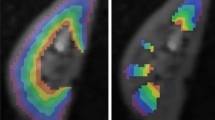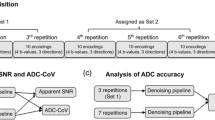Abstract
Objectives
Half-Fourier single-shot turbo spin-echo (HASTE) can be applied to diffusion-weighted (DW) imaging of the head and neck. However, HASTE DW imaging has certain drawbacks, such as severe blurring and low signal-to-noise ratio (SNR). The purpose of this study was to evaluate the influence of imaging parameters on image quality using phantoms. We also evaluated the discrimination ability of the apparent diffusion coefficient (ADC) in HASTE DW imaging to assess whether the technique is applicable to head and neck lesions.
Methods
The modulation transfer function (MTF), SNR, and ADC were compared using dedicated phantoms to evaluate the influence of matrix size (192 × 192 and 256 × 256) and receiver bandwidth (RBW 200, 400, 600, and 789 Hz/pixel) on HASTE DW images.
Results
A wide RBW setting tended to improve the MTF, regardless of the matrix size and phase-encoding direction. In contrast, a wide RBW setting tended to impair the SNR, regardless of the matrix size. At the same RBW setting, the MTF and SNR for a matrix size of 192 × 192 were higher than those for a matrix size of 256 × 256. A wide RBW setting tended to improve the discrimination ability of ADCs among the substances, regardless of the matrix size.
Conclusions
A wide RBW and small matrix size improved the MTF and SNR of HASTE DW images. A wide RBW also improved the discrimination ability of the ADC. Therefore, HASTE DWI should be performed with a wide RBW setting.






Similar content being viewed by others
References
Le Bihan D, Breton E, Lallemand D, Grenier P, Cabanis E, Laval-Jeantet M. MR imaging of intravoxel incoherent motions: application to diffusion and perfusion in neurologic disorders. Radiology. 1986;161:401–7.
Turner R, Le Bihan D, Maier J, Vavrek R, Hedges LK, Pekar J. Echo-planar imaging of intravoxel incoherent motion. Radiology. 1990;177:407–14.
Muller MF, Prasad P, Siewert B, Nissenbaum MA, Raptopoulos V, Edelman RR. Abdominal diffusion mapping with use of a whole-body echo-planar system. Radiology. 1994;190:475–8.
Schaefer PW, Grant PE, Gonzalez RG. Diffusion-weighted MR imaging of the brain. Radiology. 2000;217:331–45.
Sorensen AG, Buonanno FS, Gonzalez RG, Schwamm LH, Lev MH, Huang-Hellinger FR, et al. Hyperacute stroke: evaluation with combined multisection diffusion-weighted and hemodynamically weighted echo-planar MR imaging. Radiology. 1996;199:391–401.
Tsuruda JS, Chew WM, Moseley M, Norman D. Diffusion-weighted MR imaging of the brain: value of differentiating between extraaxial cysts and epidermoid tumors. AJR Am J Roentgenol. 1990;155:1059–65.
Okamoto K, Ito J, Ishikawa K, Sakai K, Tokiguchi S. Diffusion-weighted echo-planar MR imaging in differential diagnosis of brain tumors and tumor-like conditions. Eur Radiol. 2000;10:1342–50.
Wang J, Takashima S, Takayama F, Kawakami S, Saito A, Matsushita T, et al. Head and neck lesions: characterization with diffusion-weighted echo-planar MR imaging. Radiology. 2001;220:621–30.
Sumi M, Sakihama N, Sumi T, Morikawa M, Uetani M, Kabasawa H, et al. Discrimination of metastatic cervical lymph nodes with diffusion-weighted MR imaging in patients with head and neck cancer. AJNR Am J Neuroradiol. 2003;24:1627–34.
Yabuuchi H, Matsuo Y, Kamitani T, Setoguchi T, Okafuji T, Soeda H, et al. Parotid gland tumors: can addition of diffusion-weighted MR imaging to dynamic contrast-enhanced MR imaging improve diagnostic accuracy in characterization? Radiology. 2008;249:909–16.
Maeda M, Kato H, Sakuma H, Maier SE, Takeda K. Usefulness of the apparent diffusion coefficient in line scan diffusion-weighted imaging for distinguishing between squamous cell carcinomas and malignant lymphomas of the head and neck. AJNR Am J Neuroradiol. 2005;26:1186–92.
Sasaki M, Nakamura T. Pixel-based time-intensity curve analysis and apparent diffusion coefficient mapping of sinonasal organized hematomas. Oral Radiol. 2010;26:101–5.
Yoshino N, Yamada I, Ohbayashi N, Honda E, Ida M, Kurabayashi T, et al. Salivary glands and lesions: evaluation of apparent diffusion coefficients with split-echo diffusion-weighted MR imaging—initial results. Radiology. 2001;221:837–42.
Sakamoto J, Yoshino N, Okochi K, Imaizumi A, Tetsumura A, Kurohara K, et al. Tissue characterization of head and neck lesions using diffusion-weighted MR imaging with SPLICE. Eur J Radiol. 2009;69:260–8.
Juan CJ, Chang HC, Hsueh CJ, Liu HS, Huang YC, Chung HW, et al. Salivary glands: echo-planar versus PROPELLER diffusion-weighted MR imaging for assessment of ADCs. Radiology. 2009;253:144–52.
Tang Y, Yamashita Y, Namimoto T, Takahashi M. Characterization of focal liver lesions with half-Fourier acquisition single-shot turbo-spin-echo (HASTE) and inversion recovery (IR)-HASTE sequences. J Magn Reson Imaging. 1998;8:438–45.
Tang Y, Yamashita Y, Abe Y, Namimoto T, Takahashi M. Experimental study on HASTE sequences: impacts of parameters on liver imaging. Comput Med Imaging Graph. 1999;23:227–34.
Baltzer PA, Renz DM, Herrmann KH, Dietzel M, Krumbein I, Gajda M, et al. Diffusion-weighted imaging (DWI) in MR mammography (MRM): clinical comparison of echo planar imaging (EPI) and half-Fourier single-shot turbo spin echo (HASTE) diffusion techniques. Eur Radiol. 2009;19:1612–20.
Bammer R, Augustin M, Prokesch RW, Stollberger R, Fazekas F. Diffusion-weighted imaging of the spinal cord: interleaved echo-planar imaging is superior to fast spin-echo. J Magn Reson Imaging. 2002;15:364–73.
Lovblad KO, Jakob PM, Chen Q, Baird AE, Schlaug G, Warach S, et al. Turbo spin-echo diffusion-weighted MR of ischemic stroke. AJNR Am J Neuroradiol. 1998;19:201–8.
Kito S, Morimoto Y, Tanaka T, Tominaga K, Habu M, Kurokawa H, et al. Utility of diffusion-weighted images using fast asymmetric spin-echo sequences for detection of abscess formation in the head and neck region. Oral Surg Oral Med Oral Pathol Oral Radiol Endod. 2006;101:231–8.
Li T, Mirowitz SA. Fast T2-weighted MR imaging: impact of variation in pulse sequence parameters on image quality and artifacts. Magn Reson Imaging. 2003;21:745–53.
Chung HW, Chen CY, Zimmerman RA, Lee KW, Lee CC, Chin SC. T2-Weighted fast MR imaging with true FISP versus HASTE: comparative efficacy in the evaluation of normal fetal brain maturation. AJR Am J Roentgenol. 2000;175:1375–80.
Lipton ML. Readout modules: fast imaging. In: Lipton ML, editor. Totally accessible MRI: a user’s guide to principles, technology, and applications. New York: Springer; 2008. p. 174–86.
Elster AD, Burdette JH. Fast scanning techniques. In: Elster AD, Burdette JH, editors. Questions and answers in magnetic resonance imaging. Philadelphia: Mosby; 2001. p. 248–72.
Mitjà C, Revuelta R. Slanted edge MTF. 2008. http://rsb.info.nih.gov/ij/plugins/se-mtf/index.html. Accessed 27 March 2012.
Henkelman RM. Measurement of signal intensities in the presence of noise in MR images. Med Phys. 1985;12:232–3.
Bonnett AH, Soukup GC. NEMA standards publication MS 1-2008: determination of signal-to-noise ratio (SNR) in diagnostic magnetic resonance imaging. Rosslyn: National Electrical Manufacturers Association; 1999.
Papanikolaou N, Gourtsoyianni S, Yarmenitis S, Maris T, Gourtsoyiannis N. Comparison between two-point and four-point methods for quantification of apparent diffusion coefficient of normal liver parenchyma and focal lesions. Value of normalization with spleen. Eur J Radiol. 2010;73:305–9.
R Development Core Team. R: a language and environment for statistical computing. R Foundation for Statistical Computing, Vienna. 2009. ISBN 3-900051-07-0. http://www.R-project.org.
Chemical Society of Japan. Kagaku Binran (handbook of chemistry). Tokyo: Maruzen; 2004.
Acknowledgments
This research was supported by an Oral Health Science Center Grant (hrc8) from Tokyo Dental College, and by a project for private universities: matching fund subsidy from MEXT of Japan, 2010–2012. We would like to thank Associate Professor Jeremy Williams, Tokyo Dental College, for his assistance with the English of this manuscript.
Author information
Authors and Affiliations
Corresponding author
Rights and permissions
About this article
Cite this article
Sakamoto, J., Sasaki, Y., Otonari-Yamamoto, M. et al. Diffusion-weighted imaging of the head and neck with HASTE: influence of imaging parameters on image quality. Oral Radiol 28, 87–94 (2012). https://doi.org/10.1007/s11282-012-0091-3
Received:
Accepted:
Published:
Issue Date:
DOI: https://doi.org/10.1007/s11282-012-0091-3




